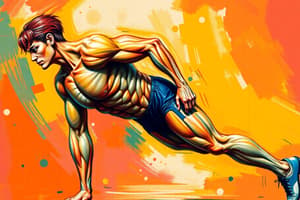Podcast
Questions and Answers
What characterizes an open kinematic chain (OKC)?
What characterizes an open kinematic chain (OKC)?
- The distal segment is restricted by external resistance.
- The motion requires the activation of all muscle groups.
- The internal load torque always exceeds the external load torque.
- The distal segment moves freely without external resistance. (correct)
Which statement is true regarding closed kinematic chains (CKC)?
Which statement is true regarding closed kinematic chains (CKC)?
- CKC requires the distal segment to meet considerable external resistance. (correct)
- CKC is characterized by isotonic muscle contractions only.
- CKC primarily focuses on muscle lengthening during movement.
- CKC allows for greater freedom of motion than OKC.
What is the relationship between internal and external torque during isometric muscle contraction?
What is the relationship between internal and external torque during isometric muscle contraction?
- Internal torque exceeds external torque significantly.
- Internal torque is unrelated to external torque.
- Internal torque is equal to external torque. (correct)
- Internal torque is less than external torque.
Which type of muscle contraction is characterized by muscle lengthening?
Which type of muscle contraction is characterized by muscle lengthening?
In a concentric contraction, which condition must be met?
In a concentric contraction, which condition must be met?
Which of the following distinguishes open kinematic chains from closed kinematic chains?
Which of the following distinguishes open kinematic chains from closed kinematic chains?
Which statement regarding muscle force generation is accurate?
Which statement regarding muscle force generation is accurate?
How does external resistance affect internal muscle torque in closed kinematic chains?
How does external resistance affect internal muscle torque in closed kinematic chains?
What does the elastic modulus indicate about a material?
What does the elastic modulus indicate about a material?
During which phase of the stress-strain curve does the elastic modulus remain constant?
During which phase of the stress-strain curve does the elastic modulus remain constant?
Which property describes a material's ability to return to its original shape after deformation?
Which property describes a material's ability to return to its original shape after deformation?
What characterizes the intermediate region of the stress-strain curve?
What characterizes the intermediate region of the stress-strain curve?
Which of the following is a characteristic of viscoelastic materials?
Which of the following is a characteristic of viscoelastic materials?
What occurs to the work done on a material when it is stretched?
What occurs to the work done on a material when it is stretched?
What can lead to mechanical failure in biological tissues?
What can lead to mechanical failure in biological tissues?
How is viscosity affected as temperature increases?
How is viscosity affected as temperature increases?
What happens to energy when force is removed from a loaded structure?
What happens to energy when force is removed from a loaded structure?
How does rapid loading affect the stiffness of connective tissue?
How does rapid loading affect the stiffness of connective tissue?
What is a consequence of applying a load slowly to tissue?
What is a consequence of applying a load slowly to tissue?
What is the relationship between strain-rate sensitivity and different loading rates?
What is the relationship between strain-rate sensitivity and different loading rates?
What happens to stress-relaxation under conditions of rapid loading?
What happens to stress-relaxation under conditions of rapid loading?
Hysteresis in the load-deformation curve indicates what about energy usage?
Hysteresis in the load-deformation curve indicates what about energy usage?
During creep, what is observed when a tissue is subjected to a continuous load?
During creep, what is observed when a tissue is subjected to a continuous load?
What characterizes the load-deformation curve of dense connective tissue during unloading?
What characterizes the load-deformation curve of dense connective tissue during unloading?
Flashcards
Closed Kinematic Chain (CKC)
Closed Kinematic Chain (CKC)
A type of movement where the distal segment of the limb is fixed in space, engaging multiple joints and muscles simultaneously. Think of squats, push-ups, and lunges.
Open Kinematic Chain (OKC)
Open Kinematic Chain (OKC)
A type of movement where the distal segment of the limb moves freely without external resistance, allowing for isolated muscle engagement. Think of bicep curls, leg extensions, and bench press.
Isometric Contraction
Isometric Contraction
A muscle contraction where the muscle generates tension without changing its length. Think of holding something heavy still.
Concentric Contraction
Concentric Contraction
Signup and view all the flashcards
Eccentric Contraction
Eccentric Contraction
Signup and view all the flashcards
Viscosity
Viscosity
Signup and view all the flashcards
Elasticity
Elasticity
Signup and view all the flashcards
Strain
Strain
Signup and view all the flashcards
Stress
Stress
Signup and view all the flashcards
Elastic Modulus (E)
Elastic Modulus (E)
Signup and view all the flashcards
Viscoelasticity
Viscoelasticity
Signup and view all the flashcards
Creep
Creep
Signup and view all the flashcards
Initial Linearly Elastic Region
Initial Linearly Elastic Region
Signup and view all the flashcards
Intermediate Region
Intermediate Region
Signup and view all the flashcards
Final Region
Final Region
Signup and view all the flashcards
Therapeutic Range
Therapeutic Range
Signup and view all the flashcards
Stress-Strain Curves
Stress-Strain Curves
Signup and view all the flashcards
Hysteresis
Hysteresis
Signup and view all the flashcards
Strain-Rate Sensitivity
Strain-Rate Sensitivity
Signup and view all the flashcards
Energy Loss
Energy Loss
Signup and view all the flashcards
Strength
Strength
Signup and view all the flashcards
Stiffness
Stiffness
Signup and view all the flashcards
Study Notes
Open vs Closed Kinematic Chain
- Closed Kinematic Chain (CKC) occurs when the distal segment of the chain is restricted by external resistance, meaning that the end of the limb is fixed in space and cannot move freely. This type of movement typically engages multiple joints and muscle groups simultaneously, enhancing stability and functional strength. CKC exercises are also beneficial for rehabilitative purposes, as they promote joint integrity and balance. For instance, during a squat, the feet remain in contact with the ground, creating resistance through the lower extremity that allows for effective engagement of the hips, knees, and ankles.
- Open Kinematic Chain (OKC) occurs when the distal segment of the chain moves freely without external resistance, allowing for more isolated movements primarily targeting specific muscles. This type of exercise is often performed using machines or free weights, where the movement is accustomed to the direct action of the intended muscle group. The bicep curl, for example, allows the individual to focus solely on the contraction of the biceps brachii while minimizing engagement of other muscle groups, promoting strength and hypertrophy development in that specific area.
- Examples of OKC: bicep curl, leg extension, and bench press, all of which effectively target individual muscle groups while the distal ends of the limbs are not fixed. These exercises can increase muscle mass and joint flexibility.
- Examples of CKC: push-ups, squats, and lunges, which require the stabilization of the body as a whole and engage several muscles in a coordinated fashion. This promotes functional fitness and is essential for activities of daily living.
Muscle Force Generation
- Isometric
- Isometric contractions occur when a muscle generates tension without changing its length, which can be important for stabilizing joints and maintaining posture without moving the bone structure.
- In this scenario, the internal torque produced by the muscle is equal to the external torque exerted by the load or resistance. This balance allows the muscle to hold a position, providing the necessary strength to counteract external forces.
- Concentric
- Concentric contractions involve the shortening of muscle fibers as they generate force, which is crucial during movements such as lifting weights or climbing stairs, where the muscle acts to overcome resistance.
- During concentric contraction, the internal torque exerted by the muscle exceeds the external torque from the load, allowing for upward movement against gravity. This is indicative of a successful muscular effort to perform work on an object or perform a physical activity.
- Eccentric
- Eccentric contractions occur when a muscle lengthens while generating force, often during controlled movements like lowering weights or running downhill. These contractions can be particularly effective for muscle growth and strength improvements.
- In the case of eccentric contractions, the internal torque produced is less than the external torque acting on the muscle, which can lead to the lengthening of the muscle under tension. This process is significant for muscle control and the absorption of impact forces.
Basic Mechanics
- Hysteresis
- When force is applied and removed from a structure this creates a load–deformation curve
- Not all energy gained during the lengthening work is recovered during shortening work, some is lost as heat
- Strain-Rate Sensitivity
- Tissues behave differently when loaded at different rates
- Stiffness increases and larger peak forces can be applied with rapid loading
- Creep happens more slowly with rapid loading
- Tissues behave differently when loaded at different rates
Basic Mechanics Concepts
- Stress
- The force per unit area applied to a material
- Strain
- A measure of how much the object is stretched
- Stress divided by Strain
- This defines the modulus of elasticity, an indicator of how likely the object is to deform under force
Stress-Strain Curves
- Three Distinct Regions:
- Initial linearly elastic region is where slope = elastic modulus (E)
- Intermediate region exhibits yielding and nonlinear elasto-plastic material behavior
- Final region exhibits linear plasticity where slope = strain hardening modulus
- Therapeutic Range
- The elastic region of biological tissue is most important clinically
Viscoelasticity
- All connective tissues are viscoelastic materials:
- Viscosity (fluid property): material’s resistance to flow
- High viscosity fluids flow slowly (honey)
- Low viscosity fluids flow quickly (water)
- Elasticity: material’s ability to return to its original length or shape after a load is removed
- Length changes are proportional to applied loads
- Depends on collagen and elastin content
- Work and Energy
- When stretched, work is done (force x distance) and energy in the stretched material increases
- Viscosity (fluid property): material’s resistance to flow
- Creep: gradual deformation of a solid material under constant load, over time
Studying That Suits You
Use AI to generate personalized quizzes and flashcards to suit your learning preferences.
Related Documents
Description
Explore the principles of open and closed kinematic chains and how they influence muscle force generation. This quiz covers examples of each type of chain and different modes of muscle contraction including isometric, concentric, and eccentric actions. Test your understanding of basic mechanics related to force application and deformation.




